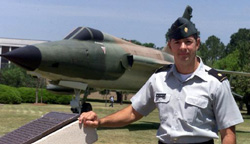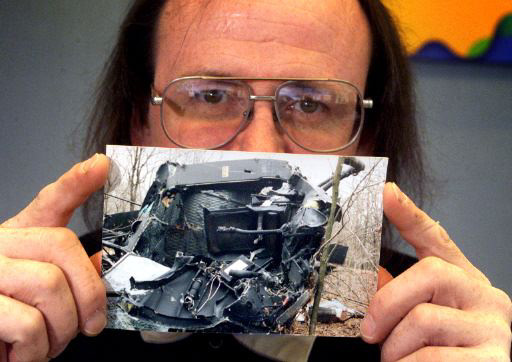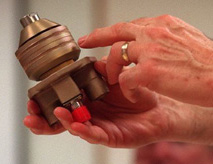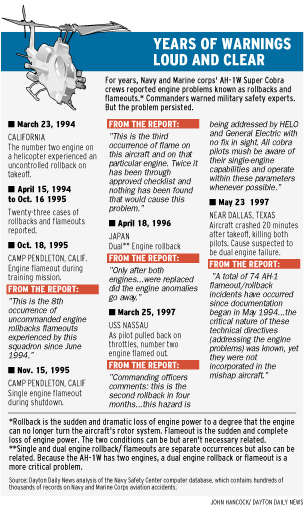 SKIP PETERSON/DAYTON DAILY NEWS SKIP PETERSON/DAYTON DAILY NEWS'FOR AS LONG AS I can remember, Thomas Nessmith wanted to be a soldier.' Army Lt. Col. Stan Nessmith (above, at Maxwell Air Force Base) wrote these words about his only brother, who was killed in a helicopter crash in Hawaii.�|
|
"It was the absolute worst place to go down," said Army Lt. Col. Stan Nessmith, who flew to the site from his job at Maxwell Air Force Base in Alabama upon hearing that his only brother was in a helicopter crash. Glamuzina and Nessmith were killed. "For as long as I can remember, Thomas Nessmith wanted to be a soldier," Lt. Col. Nessmith wrote in a memorial he had published in a Florida newspaper. "I never knew anyone who knew him who didn't like him. He had a way of walking into a room and within minutes he would have everyone laughing." 
Thomas Nesmith
|
Several weeks after the crash, Army technicians concluded that a gear failure "produced ferrous metal debris" or metal chips in the engine oil system -- a problem usually preceded by a "chip detector" warning light. That light illuminated when a magnet in the engine oil system collected enough debris to signal a potential problem. The magnets were left in the engine's oil system, but the warning light on this helicopter -- and on 800 others -- had been disconnected after pilots complained of unnecessary emergency landings. That system had been replaced by a new warning system manufactured by a company owned by Eaton Corporation of Cleveland. The new system, located in a different part of the aircraft, vaporizes metal debris with an electrical current. Unlike the old chip detector system, the Oil Debris Detection System, or ODDS, was designed to warn pilots only when the electrical current cannot vaporize the debris. After the Hawaii crash, Army technicians recommended that the service reconnect the old chip detectors because they provided "an effective warning of impending failure." But the lights were not reconnected. "We received the recommendation and decided there was no value added" by reconnecting the old warning lights, Army spokesman Mark J. Jeude said during a September briefing to Dayton Daily News reporters at the Pentagon.  SKIP PETERSON/DAYTON DAILY NEWS SKIP PETERSON/DAYTON DAILY NEWS'WE DIDN'T MAKE IT to the landing area,' said Staff Sgt. Keith Pyle, who holds a photograph showing what was left of his helicopter after it crashed in Indiana. The pilot was killed while Pyle and two other crew members were seriously injured.�
|
The lights are wrong most of the time, Jeude said, and nuisance lights are "not something we want to accept." "That's unbelievable that somebody made that decision," Lt. Col. Nessmith said. "It seems to me it's not worth the chance of somebody's life." On March 1, 1997, nine months after Army technicians recommended that the service reconnect the warning lights, four soldiers from the Indiana National Guard were flying 200 feet above an Indiana pine forest when the engine failed on their UH-1V Huey helicopter. The pilot, Chief Warrant Officer Thomas L. Miller, started a desperate diagonal descent toward a clearing in the trees. "We didn't make it to the landing area," said Staff Sgt. Keith Pyle, the crew chief, who was strapped in just behind the pilots. "I was thinking this was a bad situation and life as I know it was over. It was not a pretty picture." Just 40 yards from the clearing, with the helicopter pointed downward in a 45-degree angle toward the intended landing site, the aircraft crashed skid-first into a small grove of trees.  SKIP PETERSON/DAYTON DAILY NEWS SKIP PETERSON/DAYTON DAILY NEWSJOSEPHINE MILLER BREAKS down while talking about her husband, Chief Warrant Officer Thomas L. Miller, the pilot killed in the Indiana crash
|
Miller, a father of two, was killed in the crash. Pyle, whose full-time civilian job was driving trucks, broke his back and needs metal braces to walk. The other two crew members, Lt. Todd Bouslog and Staff Sgt. Don Brinker, also were seriously injured. The Army sent the engine to the same shop, supervised by the same people who oversaw the examination of the Hawaii wreckage. Again, the technicians recommended reconnecting the old chip-detector warning lights. If the Army wasn't going to reconnect the old warning lights, the technicians recommended, it should remove the old system altogether. The old system, they said, may be hiding potential problems by collecting debris in the engine oil system before the debris is able to make it to the ODDS warning system. Again, the Army decided not to follow the recommendation of its experts. "The old chip detector has not been reconnected or removed," said Army spokeswoman Martha Rudd. "There was no need to." In a prepared statement, the Army acknowledged that the old chip detector "might still occasionally collect some metal debris that settles to the bottom when the engine is shut down." But the ODDS system, the Army said, should alert pilots of any problems caused by this debris. This year the Air Force, through the Air Force Material Command at Wright-Patterson, began buying 65 ODDS kits for its helicopters. An additional 135 kits are earmarked for the Greek Army, and negotiations are under way with the governments of Taiwan, Turkey, Jordan and Thailand. After hearing of the newspaper's findings, Pyle, Bouslog and Miller's widow, Josephine, filed a lawsuit against the companies involved in the manufacturing of the ODDS system. The suit, filed in the federal district court in Indianapolis, alleges that the oil debris detection system on the helicopter was defective. Peter Parsons, a spokesman for the Eaton Corp., referred questions about the ODDS system to the Army.
 |  RICK MCKAY/COX NEWS SERVICE RICK MCKAY/COX NEWS SERVICETHE OIL DEBRIS DETECTION System (ODDS) full-flow debris monitor, pictured here, alerts pilots only when debris entering the two gaps cannot be vaporized by an electrical current.The old chip detector warning system, replaced by the ODDS monitor, alerted pilots with a light anytime a certain amount of debris had been collected.�| |
-- Continued --Copyright, Dayton Daily News.
|  The engine-control assembly (ECA) in the Navy's F-18 Hornet had failed 114 times when a pilot in Florida reported a problem on July 1, 1996. "Multiple ECA failures fleetwide posing unacceptable risk to aircraft crew," an investigator warned after that incident. Exactly one month later, another F-18 reported the same problem. Three months later, another was reported.
The engine-control assembly (ECA) in the Navy's F-18 Hornet had failed 114 times when a pilot in Florida reported a problem on July 1, 1996. "Multiple ECA failures fleetwide posing unacceptable risk to aircraft crew," an investigator warned after that incident. Exactly one month later, another F-18 reported the same problem. Three months later, another was reported. SKIP PETERSON/DAYTON DAILY NEWS
SKIP PETERSON/DAYTON DAILY NEWS
 SKIP PETERSON/DAYTON DAILY NEWS
SKIP PETERSON/DAYTON DAILY NEWS SKIP PETERSON/DAYTON DAILY NEWS
SKIP PETERSON/DAYTON DAILY NEWS
 RICK MCKAY/COX NEWS SERVICE
RICK MCKAY/COX NEWS SERVICE